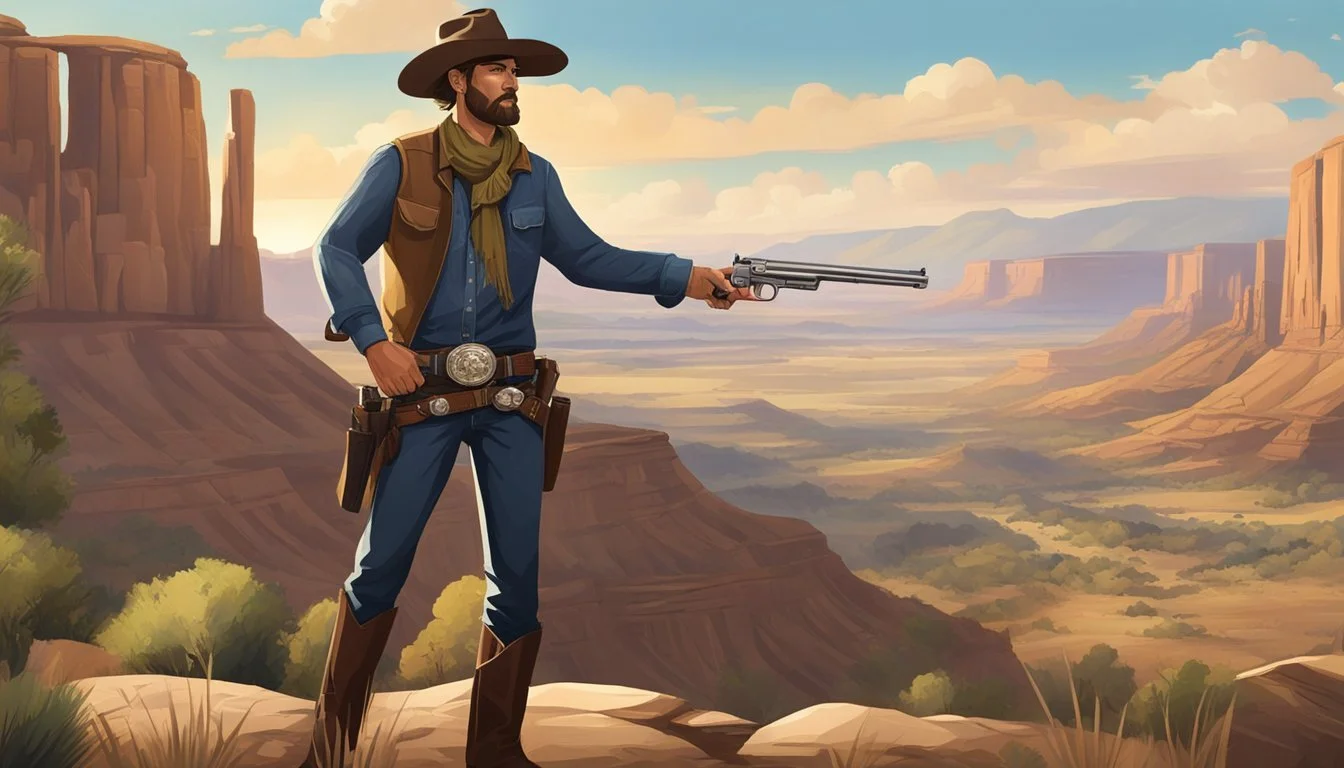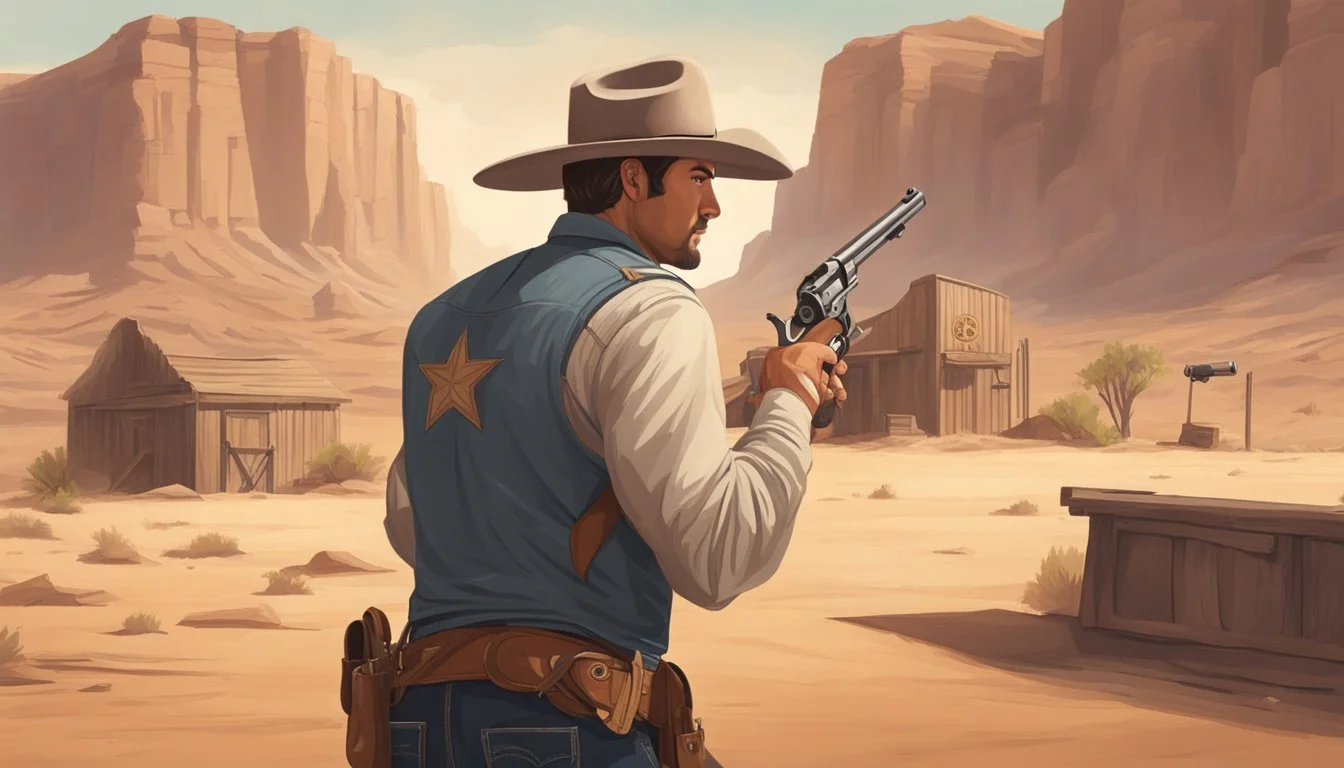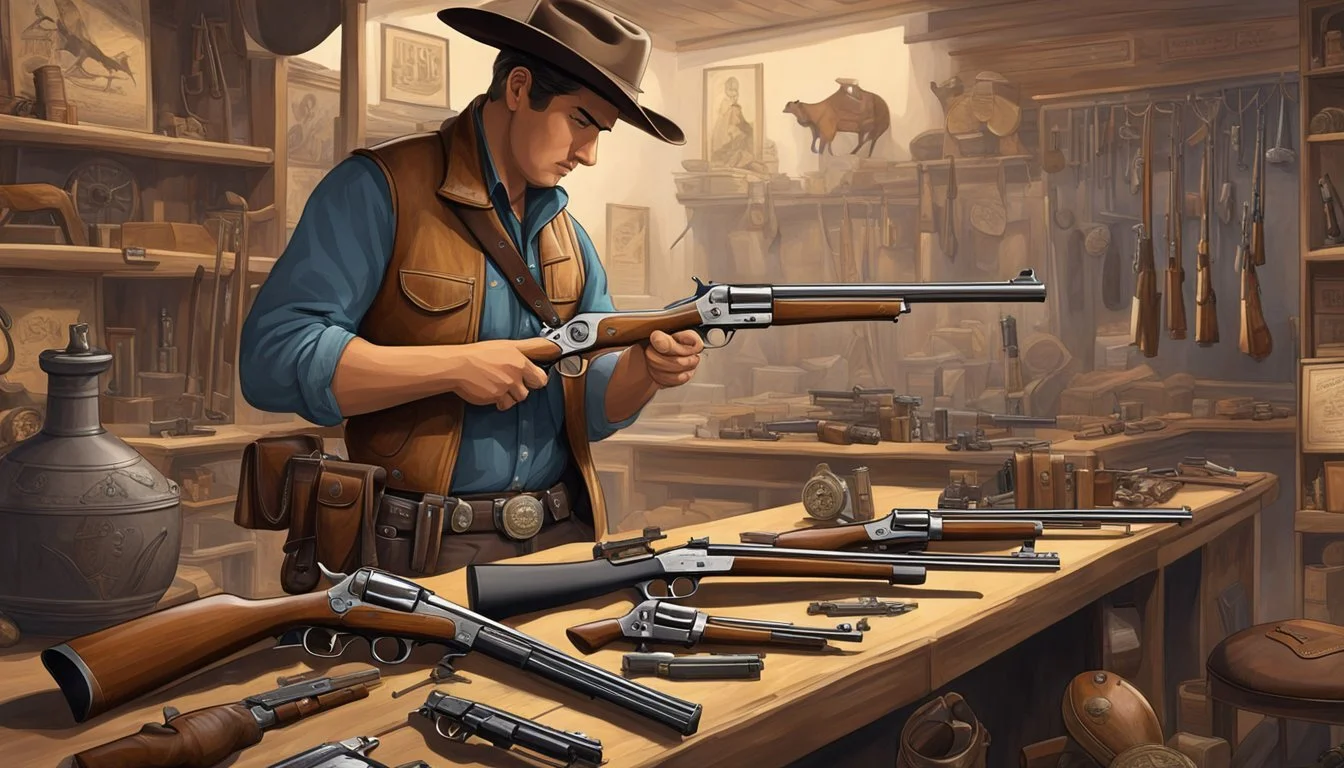The Role of Firearms in Cowboy History
Understanding Their Impact and Safety Tips
In the tapestry of American folklore, cowboys have always been depicted as symbols of resilience, adventure, and independence. Central to the identity of these frontier icons were the firearms they carried, which served not just as tools for survival but also as a means to forge the very culture of the Wild West. Firearms such as the Colt Army Revolver and Winchester Rifle became legendary, reflecting the dynamic era where they were essential for protection, hunting, and upholding justice. These guns were integral to cowboy history, influencing not only the lifestyle but also the societal norms of the time.
Safety with firearms was, and continues to be, paramount. Cowboys had to be proficient in handling their weapons, often honing their skills during the quieter moments on the range, or through the necessity of defending a cattle drive from rustlers and the dangers endemic to the frontier. Modern firearm enthusiasts and historians emphasize the importance of respecting the power and potential dangers of these weapons, advocating for responsible usage. Following proper safety protocols ensures the enduring legacy of cowboy-era firearms can be appreciated without compromising the well-being of aficionados and the public.
The Evolution of Firearms in the Old West
The Old West era witnessed a significant transformation in firearms technology, with each advancement contributing to the mythology of the American frontier. The introduction of the revolver, the refinement of rifles and shotguns, and the innovation of ammunition all played pivotal roles.
Inception of the Revolver
The revolver emerged as a game-changing weapon for pioneers of the Wild West. In 1836, Samuel Colt patented the Colt Paterson, the first practical revolving cylinder firearm, effectively inventing the six-shooter. However, it was Colt's subsequent models, including the Colt Single Action Army, commonly known as the "Peacemaker," that truly revolutionized personal defense and became synonymous with the Wild West.
Rifles and Shotguns of the Frontier
The frontier environment demanded firearms that could serve multiple purposes, from hunting to protection. Lever-action rifles, especially the Winchester Model 1873, known as "The Gun that Won the West," offered greater firepower and speed in operation, making them a favorite among settlers and the Texas Rangers. The Sharps rifle, characterized by its accuracy and range, was a preferred choice for sharpshooters and buffalo hunters, showing the varied applications of firearms in the Old West.
Ammunition Advancements
A shift from black powder to the use of metallic cartridges marked a crucial progression in ammunition during the era. The new cartridges were more reliable, easier to transport, and offered a faster reload time. The Winchester 1873 rifle was particularly notable for using metallic cartridges, which allowed for repeated firing and became the standard for rifles and handguns on the frontier. The move from cap and ball formats to pre-packaged cartridges reshaped the dynamics of gunfights and hunting, solidifying the role of firearms as central to life in the Old West.
Cowboy Action Shooting Sport
Cowboy Action Shooting (CAS) is a multifaceted competitive shooting sport that blends historical firearms with timed shooting events. It emphasizes safety, historical accuracy, and the spirit of the Old West.
Founding of Single Action Shooting Society
The Single Action Shooting Society (SASS) laid the foundation for Cowboy Action Shooting. Established in Coto de Caza, California, SASS began with loose rules that gradually solidified into a structured sport. SASS positioned itself as the worldwide governing body for CAS matches, fostering the spirit of the game and sanctioning local, regional, and international competitive shooting events.
Growth of Competitive Shooting Events
The growth of Cowboy Action Shooting events has been marked by a significant increase in participation. SASS oversees more than 95,000 members globally, reflecting the sport's popularity. Shooting events are rooted in historical shooting styles, with competitors using guns authentic to the late 19th century—like single action pistols and lever action rifles. Competitors in CAS matches are required to engage a variety of targets in specific shooting sequences, and penalty points are given for misses and procedural errors. The world championship, known as the "End of Trail," continues to attract shooters who are passionate about both competitive shooting and Western heritage.
Firearm Types and Their Roles
In the era of the Wild West, specific firearm types became hallmarks of cowboy culture, playing distinct roles due to their design and function. This section will explore the significance of revolvers, the widespread use of lever-action and pump-action rifles, and the functionality of shotguns within that historical context.
The Significance of Revolvers
Single-action revolvers were the quintessential sidearm for cowboys during the 19th century. The 1860 Colt Army Revolver and similar models required the hammer to be manually cocked before each shot, embodying the rugged, deliberate nature of Old West shootouts. Revolvers, particularly those in .32 caliber and larger, were favored for their reliability and ease of carry, allowing for quick access and use on horseback or on foot.
Lever-Action and Pump-Action Rifles
Lever-action rifles, like the 1873 Winchester Rifle, became synonymous with cowboy life, serving a critical role in defense and hunting. Their rapid firing capability, brought about by the cycling of the lever, made them ideal in confrontations where multiple shots were necessary.
Lever-Action Rifle Details:
Action Type: Lever
Popular Calibers: .44-40, .45 Colt
Notable Model: 1873 Winchester
Pump-action rifles were less common but shared similar traits with lever-actions, including the external hammer and ability for quick successive shots. Both rifle types featured prominently in the expansion of the American frontier.
The Functionality of Shotguns
Shotguns, particularly side-by-side models like the Stoeger Coach Gun, were a mainstay in stagecoach security, giving rise to the term “coach gun.” Their versatile use in close-quarters defense and their devastating effect at short range emphasized their importance. Shotguns such as the Winchester Model 1897, a pump-action design with an external hammer, were also utilized for their reliability and stopping power.
Firearms and Cowboy Lifestyle
Firearms were integral to the daily activities and survival of cowboys, serving a functional role in cattle drives, protection, and hunting throughout the evolution of the American West.
Cattle Drives and the Role of Firearms
Cattle drives were a defining aspect of cowboy life, requiring long trails from Texas to railheads in Kansas. Cowboys depended on firearms to manage and protect herds of cattle, sometimes numbering in the thousands. The trail was fraught with dangers including rustlers and predators, making a firearm an indispensable tool. A typical cowboy would carry a revolver in a leather holster on his belt, ensuring it was easily accessible. Firearms also served to signal others over long distances and to control the cattle through strategic shots into the air.
Firearms commonly carried during cattle drives:
Revolver (commonly the 1873 Colt Single Action)
Lever-action rifle (such as the 1873 Winchester)
Shotguns (less common but valued for defense)
Key figures like Charles Goodnight and Oliver Loving recognized the need for cowboys to be well-equipped with firearms as they braved the journey across territories and confronted the risks posed by the environment and potential outlaws.
Firearms for Hunting and Protection
Aside from cattle drives, firearms were essential for hunting to provide food for the crew and for personal protection against wild animals and threats from hostile encounters. Cowboys often relied on rifles for hunting, appreciating the longer range and accuracy to take down game such as deer and antelope, essential for feeding a large group on extended drives.
Common uses of firearms for hunting and protection:
Hunting game for sustenance
Deterrence and defense against predators and thieves
The "cowboy way" melded practicality with a sense of courage. Carrying a weapon didn't merely come down to utility—it was a part of the cowboy identity, a manifestation of the rugged individualism and resilience that defined a cowboy or cowgirl's life in the West. Moreover, firearms were a strong part of the legacy following the Civil War, often signifying a cowboy's military past and proficiency in arms.
Firearms held by cowboys were frequently customized with leather holsters and belts, showing customization for quick draw and personal style, displaying a blend of functionality and personal expression within the cowboy culture.
Firearm Safety and Handling Tips
In the context of cowboy history and the practical use of firearms, safety and proper handling are paramount. This section provides guidance on ensuring responsible firearm management, focusing on training and maintenance.
The Importance of Proper Training
Proper training is the cornerstone of firearm safety. Individuals should engage with certified professionals or range officers who can instruct on the correct handling of firearms. Training often includes mastering safe firearm positioning, managing the angle of safety to avoid mishaps, and learning the specific rules such as the widely adopted 170-degree safety rule. This rule ensures that the muzzle of the firearm does not point at anything beyond its safe angle, especially in a competitive environment like cowboy action shooting.
Maintenance and Cleaning Techniques
Maintaining and cleaning firearms are critical for both safety and the longevity of the weapons. Regular maintenance minimizes the risk of malfunctions that could lead to accidental gunfire. A clean firearm is also more accurate and reliable when it comes to trigger pull.
Disassembly: Follow the manufacturer's instructions to disassemble the firearm.
Cleaning: Use the appropriate solvents and brushes to clean each component, including the barrel, action, and cartridge belt if applicable.
Inspection: Examine for signs of wear or damage that a gunsmith should address.
Lubrication: Apply lubricant sparingly to the moving parts.
Reassembly: Ensure each part is correctly reinstalled.
Operators should also manage ammunition carefully, using a loading table for preparing firearms before shooting and an unloading table to clear them after use. It's imperative that firearms are not loaded until the moment before use, and cartridges are removed promptly when no longer actively engaged in shooting. Proper storage in a gun cart or secured area is also essential, as is keeping ammunition in cartridge belts designed for quick access but safe carriage.
Firearms in Contemporary Cowboy Culture
The allure of the Wild West lives on in modern cowboy culture, where historical firearms are not only collected but also put to use in various forms of reenactment and competition, merging historical reverence with contemporary enjoyment.
Modern Interpretation and Reenactment
Contemporary enthusiasts often engage in historical reenactment, donning period-appropriate costumes to embody cowboys of yore. Authenticity is key; from headwear to holsters, every detail is crafted to represent the era accurately. Companies like Cimarron and Uberti manufacture replicas of iconic firearms such as the 1873 Winchester, known for its tubular magazine and the 1874 Sharps Rifle. These replicas are both affordable and functional, offering a budget-friendly option for enthusiasts to relive the cowboy legacy.
Cowboy Action Shooting as a Hobby
Cowboy Action Shooting (CAS), sanctioned by the Single Action Shooting Society (SASS), stands as a popular competitive hobby wherein participants engage in timed shooting stages with firearms typical of the late 19th century. Key firearms in this discipline include the Marlin lever-action rifle, Ruger Vaquero revolvers, and double-barreled or 1897 pump-action 20-gauge shotguns. Competitors often adopt aliases and compete in categories like Duelist and Gunfighter, emphasizing speed and accuracy. Firearms used in CAS must look the part but are often modified for safety and performance, catering to the unique blend of historical appreciation and competitive spirit in contemporary cowboy culture.
Choosing the Right Gear for Cowboy Shooting
When preparing for cowboy action shooting, selecting the appropriate firearms and cowboy gear is crucial for authenticity and performance. Accuracy, historical fidelity, and safety are paramount.
Selecting Firearms and Accoutrements
Firearms: A competitor needs three main types of firearms for cowboy action shooting: a pair of revolvers, a rifle, and a shotgun. The revolvers should be single-action, resembling the iconic Colt Peacemaker. The rifles used are typically lever-action models from the late 19th century, such as replicas of the Winchester Model 1873. Shotgun choices are often either a pump, resembling the Winchester Model 1897, or a classic coach gun—a side-by-side double-barrel shotgun.
Firearm Type Examples Revolvers Colt Single Action Army, Cimarron, Uberti Rifles Winchester Model 1873 reproduction, Marlin 1895 Cowboy Shotguns Winchester Model 1897 pump, IAC Imports double-barrel
Holsters and Belts: Leather is the material of choice for holsters and belts, contributing to both the look and function of the shooter's outfit. A gunfighter might wear a belt with holsters positioned for a quick draw.
Costume and Accoutrements: Authenticity in cowboy action shooting extends beyond firearms. Participants adorn themselves with costumes that reflect the late 19th-century period. A typical costume may include a bandana, hat, and period-appropriate shirts and trousers. Gun carts are used to transport firearms and ammunition between stages, and steel targets are set up for the shooting stages.
Understanding Cowboy Gear Customization
Cowboy action shooters often personalize their gear for both function and authenticity. Customization might include:
Revolvers: Tuning for a smoother action or custom grips.
Rifles and Shotguns: Adjustment of sights and action work for reliability.
Holsters: Tailoring for a snug fit and quick draw capabilities, as well as personalized designs and carvings on the leather.
Costume: Period-accurate attire is further tailored to the individual, potentially reflecting a character from the Old West that a shooter wishes to emulate.
Customization not only enhances the shooter's connection to the history but also may offer a competitive edge in terms of speed and handling. Choosing and customizing the right gear is a central aspect of the sport that allows for a combination of historical appreciation and practical firearm use.




